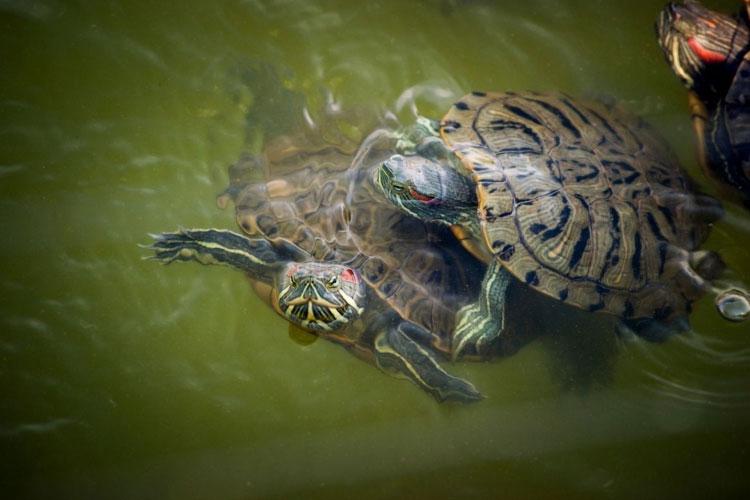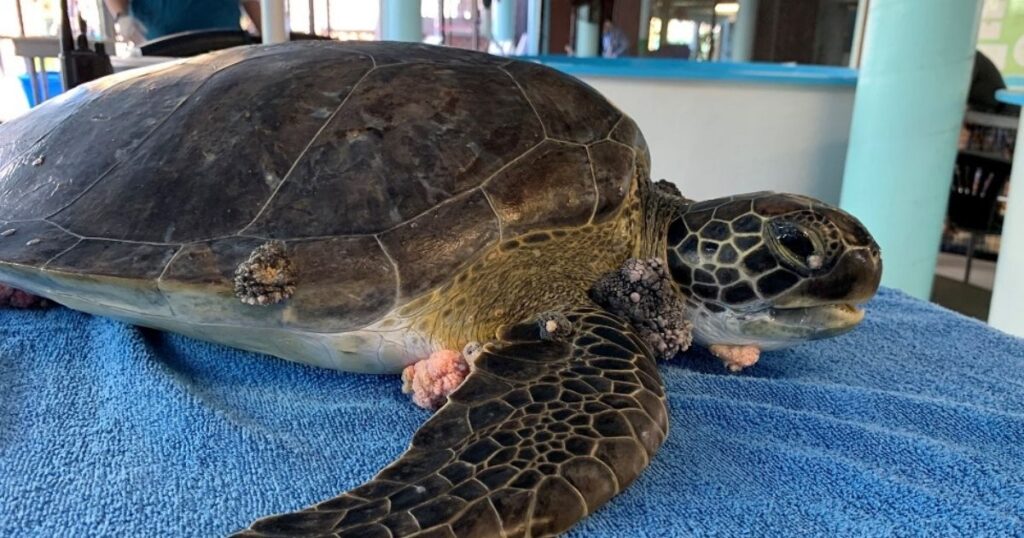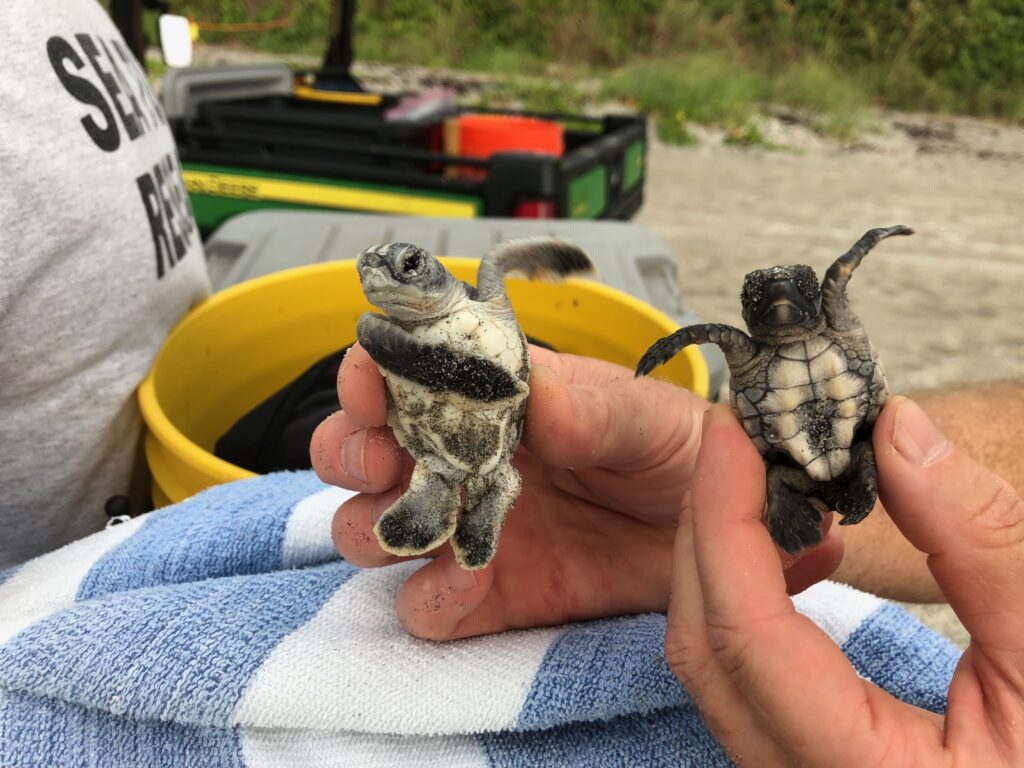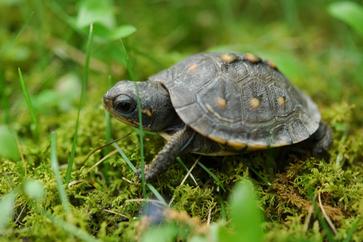In this article, we will explore the importance of natural sunlight for the healthy growth of baby turtles. We will discuss how sunlight helps them develop strong shells and bones, boosts their immune system, and enhances their overall well-being. Additionally, we will discover the ideal amount of sunlight exposure and the potential risks of not getting enough. By the end of this article, you will have a clearer understanding of why natural sunlight plays a vital role in the growth and development of baby turtles.

Introduction
When it comes to the well-being of baby turtles, sunlight plays a crucial role in their growth and development. As cold-blooded reptiles, turtles rely on external sources of heat to regulate their body temperature and carry out essential biological processes. In this article, we will explore the importance of sunlight for baby turtles and delve into how it affects their physical development, immune system, behavior, and nutrient absorption. Furthermore, we will discuss the role of sunlight in the conservation of these magnificent creatures and provide guidelines for ensuring their healthy sunlight exposure.
Importance of Sunlight for Baby Turtles
Sunlight is vital for the healthy growth of baby turtles due to several reasons. Firstly, sunlight plays a crucial role in the synthesis of Vitamin D in their bodies. Vitamin D is essential for the proper development of bones and helps in the absorption of calcium. This, in turn, leads to the development of a strong and protective shell, a key characteristic of turtles. Moreover, sunlight is also responsible for regulating the growth and metabolism of baby turtles.
Life Cycle of Baby Turtles
Understanding the life cycle of baby turtles allows us to comprehend the significance of sunlight in their development. Baby turtles, also known as hatchlings, emerge from their nests and embark on a challenging journey towards the ocean. The hatching process occurs primarily at night, where babies make their way out of the sand and rely on the moonlight to guide them towards the water. Once in the ocean, these young turtles face numerous hurdles and must adapt quickly to survive in their new aquatic environment.
Physical Development of Baby Turtles
Sunlight plays a fundamental role in the physical development of baby turtles. As hatchlings, they possess a soft and pliable shell, known as a carapace. The exposure to sunlight triggers a process called calcification, where the carapace hardens and provides protection to the vulnerable turtle. Furthermore, sunlight contributes to the overall growth of the baby turtle, ensuring that it reaches its full potential. The combination of sunlight and a nutrient-rich diet is crucial for their optimal physical development.

Effects of Sunlight on Baby Turtles
Vitamin D Synthesis
Sunlight is essential for baby turtles as it allows them to synthesize Vitamin D in their bodies. When sunlight interacts with their skin, a specific compound is converted into an active form of Vitamin D. This crucial vitamin aids in the absorption of calcium, which is necessary for the development of strong and healthy bones. Without adequate sunlight exposure, baby turtles may suffer from weakened bones or shell abnormalities.
Shell Development
A robust and sturdy shell is of utmost importance for baby turtles. Sunlight plays a vital role in the proper development of their shell, ensuring it grows healthy and strong. The exposure to sunlight triggers the production of keratin, a protein that contributes to the structure and growth of the shell. Additionally, sunlight also aids in the process of shell repair, allowing baby turtles to heal any damages or injuries sustained during their journey in the wild.
Growth and Metabolism
Sunlight is not only crucial for the physical development of baby turtles but also essential for their overall growth and metabolism. Exposure to natural sunlight provides them with warmth, which is necessary for maintaining their body temperature and carrying out metabolic processes efficiently. Furthermore, sunlight stimulates their appetite, enabling them to consume the necessary nutrients they need for healthy growth. Without proper sunlight exposure, baby turtles may experience stunted growth and weakened immune systems.
UV Radiation and Baby Turtles
While sunlight provides various benefits to baby turtles, it is important to understand the effects of UV radiation on their health and well-being. UV radiation is a component of sunlight that can have both positive and negative impacts on baby turtles.
UV Radiation and Health
Moderate exposure to UV radiation is essential for baby turtles’ health. UV radiation triggers the synthesis of Vitamin D, aids in the absorption of essential nutrients, and stimulates their immune system. However, excessive exposure to UV radiation can be harmful, leading to sunburns, eye damage, and even the development of cancerous cells. Therefore, it is crucial to strike a balance between adequate sunlight exposure and protecting baby turtles from excessive UV radiation.
UV Radiation and Shell Strength
UV radiation also plays a role in maintaining the strength and integrity of the turtle’s shell. Controlled exposure to UV radiation allows for the proper production and distribution of melanin, a pigment responsible for pigmentation in the shell. Melanin helps protect the shell from UV radiation damage and maintains its strength and durability. However, excessive UV radiation can cause shell degradation and weaken its structure, making baby turtles more susceptible to injuries and infections.
UV Radiation and Thermoregulation
The ability to regulate body temperature is vital for baby turtles’ survival. UV radiation plays a significant role in thermoregulation, as it provides warmth and helps maintain their preferred body temperature. Baby turtles bask in the sunlight to absorb heat, allowing them to carry out metabolic processes efficiently. Moreover, UV radiation affects the water temperature, which impacts the turtle’s ability to find food and navigate their surroundings.

Role of Sunlight in Behavior
Sunlight not only has physiological effects on baby turtles but also influences their behavior. The availability of natural sunlight affects various aspects of their daily lives, including sunbathing, navigation, and activity patterns.
Sunbathing and Basking
Basking is a common behavior observed in baby turtles and serves multiple purposes. Sunbathing allows them to absorb heat from the sunlight, regulate their body temperature, and enhance their metabolism. Additionally, basking also aids in the drying of their shells, preventing the growth of harmful bacteria or fungi. The availability of suitable basking spots with access to natural sunlight is crucial for their overall well-being.
Navigation and Orientation
Baby turtles rely on visual cues, including sunlight, for navigation and orientation purposes. As they make their way towards the ocean after hatching, the presence of moonlight or sunlight on the horizon helps guide them in the right direction. Once in the water, sunlight serves as a visual marker, allowing them to find food sources and avoid potential dangers. The availability of natural sunlight is essential for their successful navigation and survival in the ocean.
Daily Activity Patterns
Sunlight plays a significant role in shaping baby turtles’ daily activity patterns. These reptiles are diurnal, meaning they are most active during the day and rest during the night. The presence of natural sunlight stimulates their activity levels, encouraging them to engage in essential behaviors such as hunting, exploring, and socializing. Adequate sunlight exposure ensures a healthy and active lifestyle for baby turtles.
Sunlight and Nutrient Absorption
Sunlight not only affects baby turtles’ physical development but also plays a crucial role in nutrient absorption. Several essential nutrients are absorbed more efficiently in the presence of sunlight, including calcium, phosphorus, and vitamin D.
Calcium Absorption
Calcium is a vital nutrient required for the development and maintenance of strong bones and shells in baby turtles. Sunlight stimulates the production of Vitamin D, which facilitates the absorption of calcium from their diet. With proper sunlight exposure, baby turtles can efficiently absorb calcium, preventing deficiencies and ensuring healthy skeletal growth.
Phosphorus Absorption
Phosphorus is another essential nutrient that works in conjunction with calcium to maintain optimal bone health. Sunlight aids in the absorption of phosphorus, allowing baby turtles to utilize this nutrient effectively. The combination of adequate sunlight and a nutrient-rich diet ensures that baby turtles receive the necessary phosphorus for their growth and development.
Other Essential Nutrients
Sunlight also plays a role in the absorption of other essential nutrients crucial for baby turtles’ well-being. Vitamin D, synthesized through sunlight exposure, enhances the absorption of various vitamins and minerals necessary for their overall health. These include vitamins A, E, and K, as well as minerals such as magnesium and zinc. Therefore, providing baby turtles with access to natural sunlight ensures optimal nutrient absorption and promotes their healthy growth.

Temperature and Sunlight
The relationship between temperature and sunlight is intricate when it comes to baby turtles’ growth and well-being. Both factors are closely intertwined and have significant implications for their survival and development.
Effect of Temperature on Sunlight Exposure
Temperature affects the availability and intensity of sunlight for baby turtles. Cooler temperatures can limit the amount of sunlight that reaches these reptiles, inhibiting their growth and potentially affecting their metabolism. On the other hand, higher temperatures promote increased sunlight exposure, allowing baby turtles to regulate their body temperature and carry out essential physiological processes more efficiently.
Thermoregulation and Growth
Proper thermoregulation is vital for baby turtles to thrive. Sunlight provides them with the necessary warmth to maintain their preferred body temperature and engage in metabolic processes effectively. The availability of sunlight ensures that baby turtles can efficiently digest their food, absorb nutrients, and promote healthy growth. Temperature influences the duration and intensity of sunlight exposure, which directly impacts their ability to thermoregulate and support their growth.
Seasonal Shifts in Sunlight Intensity
Seasonal changes affect the intensity and duration of sunlight, which can impact baby turtles’ growth patterns. During colder seasons, sunlight availability decreases, leading to reduced metabolic activity and growth rate. However, as warmer seasons arrive and sunlight becomes more abundant, baby turtles experience a surge in growth and metabolism. Understanding these seasonal dynamics is crucial for turtle keepers and conservationists to ensure optimal conditions for their healthy growth and development.
Sunlight and Immune System
A well-functioning immune system is vital for baby turtles’ long-term health and survival. Sunlight plays a significant role in supporting their immune system and protecting them from diseases and infections.
UV Radiation and Immune Function
UV radiation, a component of sunlight, stimulates the immune system of baby turtles. When exposed to UV radiation, their bodies produce antimicrobial peptides, which play a crucial role in fighting off pathogens and preventing infections. Adequate sunlight exposure enhances the immune response and reinforces their defense mechanisms, ensuring their overall well-being.
Vitamin D and Immunity
Sunlight enables the synthesis of Vitamin D, which is known to have immunomodulatory effects. Vitamin D plays a crucial role in regulating the immune system and helps baby turtles develop resilience against diseases and infections. A deficiency in Vitamin D can lead to a compromised immune system, making baby turtles more susceptible to illnesses. Therefore, proper sunlight exposure is essential to maintain a robust immune system and prevent the onset of diseases.
Disease Prevention
Sunlight and UV radiation also aid in preventing the growth of harmful bacteria and fungi on the shells and skin of baby turtles. The exposure to natural sunlight helps to keep their shells dry and reduces the risk of infection. It also assists in the natural shedding of their skin, preventing the buildup of parasites or disease-causing microorganisms. A well-maintained immune system, supported by adequate sunlight exposure, is crucial for the overall health and well-being of baby turtles.

Artificial Light vs. Natural Sunlight
While artificial light sources can provide some benefits for baby turtles, natural sunlight remains unparalleled in promoting their healthy growth and development. It is essential to understand the limitations of artificial light and prioritize natural sunlight whenever possible.
Comparing Artificial Light Sources
Various artificial light sources, such as full spectrum UVB lamps or specialized reptile lighting, attempt to replicate the effects of natural sunlight. While they can provide the necessary UV radiation and some heat, they often fall short in terms of replicating the full spectrum of light wavelengths present in natural sunlight. Additionally, artificial light sources may not provide the same psychological benefits and stimulation that natural sunlight offers.
Limitations of Artificial Light
Artificial light sources may not fully encompass the complex lighting and temperature variations baby turtles would experience in their natural habitats. Replicating the diverse natural environment, including sunlight intensity, heat gradients, and daily light cycles, is a challenging task for artificial lighting setups. Furthermore, extended reliance on artificial light sources may cause stress or disrupt the natural behaviors of baby turtles.
Importance of Natural Sunlight
Natural sunlight provides a multitude of benefits that artificial light sources cannot fully replicate. The unique combination of light wavelengths, temperature variations, and daily light cycles found in natural sunlight is essential for baby turtles’ overall health and well-being. Whenever possible, providing baby turtles with access to natural sunlight should be prioritized, as it ensures the most optimal conditions for their growth and development.
Conservation and Sunlight
Understanding the role of sunlight in the lives of baby turtles carries significant implications for their conservation. Protecting their natural habitats and ensuring access to sunlight are crucial aspects of their well-being.
Protecting Natural Habitats
Conservation efforts must prioritize the preservation and protection of baby turtles’ natural habitats. Proper management of nesting areas, minimizing pollution, and preventing habitat destruction are vital for sustaining healthy populations. Preserving natural habitats allows baby turtles to access sunlight naturally, ensuring their healthy growth and development.
Ensuring Access to Sunlight
In situations where baby turtles are under human care, providing suitable outdoor enclosures is crucial for their well-being. These enclosures should allow adequate sunlight exposure, replicate their natural habitat conditions, and provide access to basking spots. Additionally, ensuring that enclosures are well-maintained and free from physical barriers will allow baby turtles to receive the sunlight and warmth they require.
Conservation Practices
Conservation organizations and turtle keepers can play an active role in promoting the importance of natural sunlight for baby turtles. Educating the public about the significant role sunlight plays in their growth and well-being can garner support for conservation efforts. Additionally, conservation practices should prioritize protecting natural habitats, minimizing human disturbances, and implementing strategies that facilitate natural sunlight exposure for baby turtles.
Research and Findings
A significant body of scientific research supports the importance of natural sunlight in promoting healthy growth in baby turtles. Several studies have explored the effects of sunlight exposure on their physical development, shell strength, immune system, and overall well-being. While variations exist based on species and environmental conditions, the findings consistently emphasize the crucial role of sunlight in their optimal growth and development.
Impact of Sunlight Deprivation
Research has demonstrated the detrimental effects of sunlight deprivation on baby turtles. Lack of access to natural sunlight can lead to weakened shells, stunted growth, compromised immune systems, and increased disease susceptibility. Additionally, sunlight deprivation can also affect their behavior, causing reduced activity levels and an overall decline in their well-being.
Optimal Sunlight Exposure
Studies have shown that providing baby turtles with optimal sunlight exposure positively impacts their growth and overall health. The correct balance between sunlight and shade, along with appropriate temperature variations, ensures their ability to thermoregulate and carry out physiological processes efficiently. Research suggests that offering baby turtles at least 12-14 hours of natural sunlight, supplemented with proper nutrition, promotes their healthy development.
Managing Sunlight Exposure
To ensure the healthy growth of baby turtles, proper management of their sunlight exposure is crucial. This involves creating suitable outdoor enclosures, monitoring and regulating sunlight intensity, and providing them with adequate care.
Building Suitable Outdoor Enclosures
The construction of outdoor enclosures should prioritize replicating the natural environment of baby turtles as closely as possible. This involves ensuring access to both sunlight and shade, providing basking spots, and incorporating elements that mimic their natural habitats. Additionally, enclosures should be secure and protected from potential predators, allowing baby turtles to bask and explore their surroundings safely.
Sunlight Monitoring and Regulation
Monitoring sunlight exposure is essential to prevent overexposure or deprivation. Temperature and UV light meters can help assess the intensity and quality of sunlight within the enclosure. This enables turtle keepers to regulate sunlight exposure by providing shade or adjusting the basking areas as needed. Regular monitoring safeguards against potential health issues arising from extreme sunlight exposure or prolonged shade.
Proper Handling and Care
Proper handling and care also contribute to the healthy growth of baby turtles. Turtle keepers should ensure the turtles receive adequate nutrition, a suitable living environment, and regular veterinary check-ups. Additionally, baby turtles should be handled with care, considering their vulnerability and sensitivity. Proper hygiene practices, including regular cleaning of their enclosures and avoiding the introduction of harmful pathogens, are crucial for their well-being.
Educating Turtle Keepers
One of the key aspects of promoting healthy sunlight exposure for baby turtles is educating turtle keepers about their unique requirements. Understanding the importance of sunlight and implementing proper care practices is vital for their long-term health and well-being.
Understanding Sunlight Requirements
Turtle keepers should familiarize themselves with the specific sunlight requirements of the turtle species they are caring for. Different species have varying preferences for sunlight intensity, duration, and temperature. It is crucial to provide suitable conditions that closely mimic their natural habitats to ensure their optimal growth and development.
Guidelines for Healthy Sunlight Exposure
Providing turtle keepers with clear guidelines regarding healthy sunlight exposure is essential. These guidelines should encompass factors such as temperature variations, the appropriate duration of sunlight exposure, and measures to prevent overexposure. Educating turtle keepers about these guidelines enables them to provide a suitable environment that promotes the healthy growth of baby turtles.
Common Misconceptions
Clearing misconceptions regarding sunlight exposure is vital to ensure the well-being of baby turtles. Some turtle keepers may mistakenly believe that artificial light sources are sufficient to meet their sunlight requirements. Educating them about the limitations of artificial light and emphasizing the significance of natural sunlight is crucial. Additionally, dispelling any misconceptions surrounding excessive sunlight exposure and providing proper guidance helps turtle keepers create a nurturing environment for their baby turtles.
Risk Factors and Precautions
While sunlight is crucial for baby turtles’ healthy growth, several risk factors and precautions must be taken into account to ensure their safety and well-being.
Overexposure to Sunlight
Overexposure to sunlight, especially UV radiation, can be harmful to baby turtles. This can result in sunburns, dehydration, and potential damage to their eyes. It is essential to monitor their exposure and provide shade or shelters within the enclosure. Additionally, ensuring a gradual increase in sunlight exposure and avoiding sudden changes in intensity can prevent potential harm.
Extreme Weather Conditions
Extreme weather conditions, such as heatwaves or severe cold, can adversely affect baby turtles. In extreme heat, providing additional shade or misting the enclosure can help lower the temperature and prevent dehydration. Conversely, during cold weather, maintaining adequate warmth within the enclosure is crucial to prevent hypothermia. Monitoring weather conditions and taking necessary precautions safeguards the health and well-being of baby turtles.
Supervision and Safety Measures
Supervision is crucial when baby turtles are exposed to natural sunlight, especially in outdoor enclosures. Regular monitoring ensures their safety and allows prompt intervention in the case of any potential risks or health issues. Additionally, providing safe and secure enclosures, free from potential hazards or predators, minimizes risks and ensures the turtles can bask and thrive in a protected environment.
Conclusion
In conclusion, natural sunlight plays a vital role in promoting healthy growth and well-being in baby turtles. Adequate sunlight exposure enables the synthesis of Vitamin D, enhances shell development, regulates growth and metabolism, and supports a robust immune system. Additionally, sunlight influences their behavior, nutrient absorption, and thermoregulation. While artificial light sources can provide some benefits, they fall short in replicating the full spectrum of sunlight and the diverse natural environment experienced by baby turtles. Prioritizing access to natural sunlight and implementing proper care practices ensures the optimal development and long-term health of these magnificent creatures. By understanding the role of natural sunlight and promoting its importance, we can contribute to the conservation of baby turtles and ensure their survival for generations to come.
